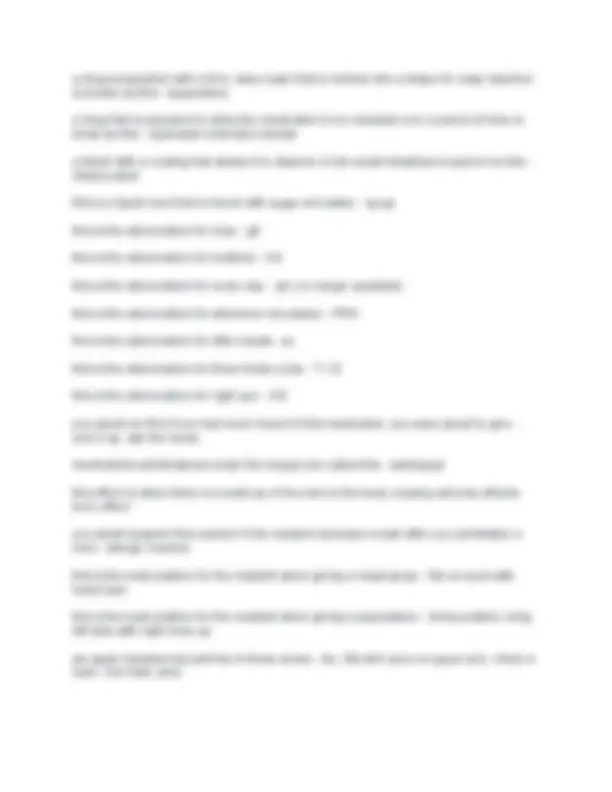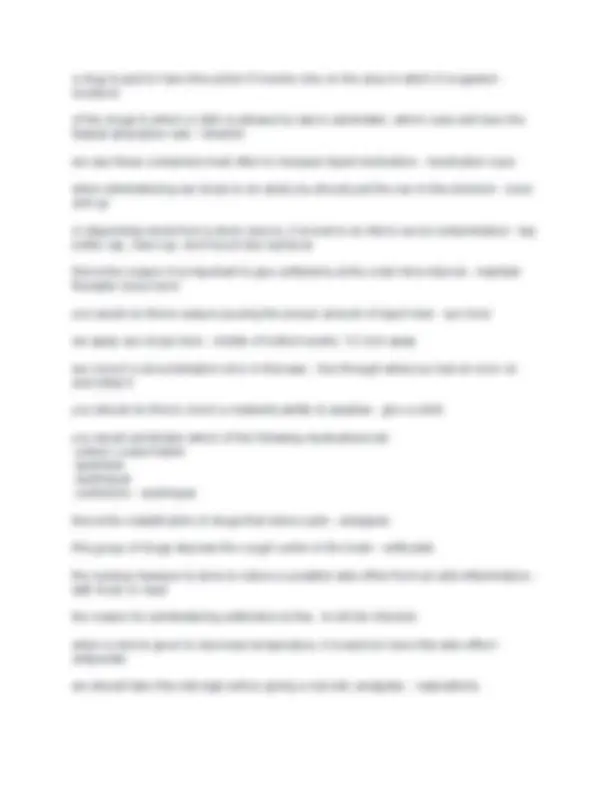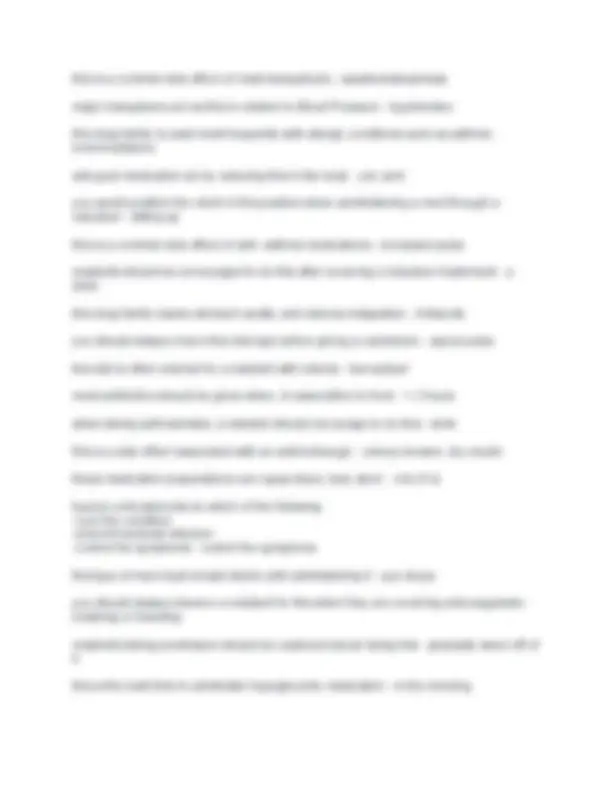





Study with the several resources on Docsity

Earn points by helping other students or get them with a premium plan


Prepare for your exams
Study with the several resources on Docsity

Earn points to download
Earn points by helping other students or get them with a premium plan
Community
Ask the community for help and clear up your study doubts
Discover the best universities in your country according to Docsity users
Free resources
Download our free guides on studying techniques, anxiety management strategies, and thesis advice from Docsity tutors
A comprehensive overview of medication administration for certified medication aides (cmas). It covers essential aspects of medication safety, including the six rights of medication administration, drug classifications, common side effects, and proper administration techniques. The document also includes a glossary of abbreviations and terms commonly used in medication administration.
Typology: Exercises
1 / 6

This page cannot be seen from the preview
Don't miss anything!




This person is directly responsible for what a Medication Aide does. - you, self Before giving any medications, you read the label this many times - three This person is responsible for replacing unreadable labels on medication containers - The Pharmacy The medication aide can dispense only these parenteral medications - none This person is responsible for the drug storage container - The person administering the drugs You would do this if you think the medication order is wrong. - Check with the nurse You would do this if a resident questions a medication. - Hold the medication until you check doc's order (nurse) This state agency in Iowa is responsible for defining the role of the Med Aide - DIA ( department of inspections and appeals This federal legislation requires that all drugs be tested prior to marketing - FDA you would do this if a medication is refused by the resident - discard in appropriate place. or wait and try again it is the medication aides responsibility to do which of the following -transcribe Dr's orders -calculate drug dosages
which of these should be included with a Dr's order or prescription -amount of medication to be given -expiration date -method of administration -possible side effects of medication -amount of medication to be given - amount of medication to be given expiration date method of adminteration amount of medication to be given these are the 6 rights of medication administration - right drug, right time, right dose, right person, right route this is a proper way of dispensing of a unused schedule II drug - in proper drug disposal, with another nurse to sign off true or false. med aides can administer schedule II- controlled substance - True these schedule drugs are the lowest potential for abuse - schedule IV ( robitussin, cough drops) these schedule drugs are said to be highly addictive with no pharmaceutical value - Schedule I ( heroin, LSD, marijauna) the med aide must do this before giving any PRN medication - check MAR, nurse. check pain level the majority of drugs today come from these products - synthetic individually wrapped medication is said to come in this - unit dose medications prepared in large amount and that can be given to different residents are know as - stock which of the following are metric units of measure -gram -liter -milligram -ounce - gram liter milligram the universal name assigned to a drug that describes the drug's chemical structure is this - generic name
a drug is said to have this action if it works only on the area in which it is applied - localized of the drugs in which a CMA is allowed by law to administer, which route will have the fastest absorption rate - inhalent we use these containers most often to measure liquid medication - medication cups when administering ear drops to an adult you should pull the ear in this direction - back and up in dispensing meds from a stock source, it is best to do this to avoid contamination - tap bottle cap, med cup, don't touch two surfaces this is the reason it is important to give antibiotics at the order time interval - maintain theraptic blood level you would do this to assure pouring the proper amount of liquid med - eye level we apply eye drops here - middle of bottom eyelid, 1/2 inch away we correct a documentation error in this way - line through what you had an error on and initial it you should do this to check a residents ability to swallow - give a drink you would administer which of the following medications list -enteric coated tablet -spansule -sublinqual -cartiotonic - sublinqual this is the classification of drugs that relieve pain - analgesic this group of drugs depress the cough center in the brain - antitussin the nursing measure is done to relieve a possible side effect from an anti-inflammatory - with food/ or meal the reason for administering antibiotics is this - to kill the infection when a med is given to decrease temperature, it is said too have this side effect - antiparatic we should take this vital sign before giving a narcotic analgesic - respirations
this is a common side effect of most tranquilizers - sedation/sleepiness major tranqulizers act as this in relation to Blood Pressure - hypotensive this drug family is used most frequently with allergic conditions such as asthma - bronchodilators anti-gout medication act by reducing this in the body - uric acid you would position the client in this position when administering a med through a nebulizer - sitting up this is a common side effect of anti- asthma medications - increased pulse residents should be encouraged to do this after receiving a nebulizer treatement - a drink this drug family lowers stomach acidity and relieves indigestion - Antiacids you should always check this vital sign before giving a cardiotonic - apical pulse this diet is often ordered for a resident with edema - low sodium most antibiotics should be given when, in association to food - 1-2 hours when taking sulfonamides, a resident should encourage to do this - drink this is a side effect associated with an anticholinergic - urinery tension, dry mouth these medication preparations can cause black, tarry stool. - iron (Fe) topical corticosteroids do which of the following -cure the condition -prevent bacterial infection -control the symptoms - control the symptoms this type of med must remain sterile until administering it - eye drops you should always observe a resident for this when they are receiving anticoagulants - brushing or bleeding residents taking prednisone should be cautioned about doing this - gradually ween off of it this is the best time to administer hypoglycemic medication - in the morning